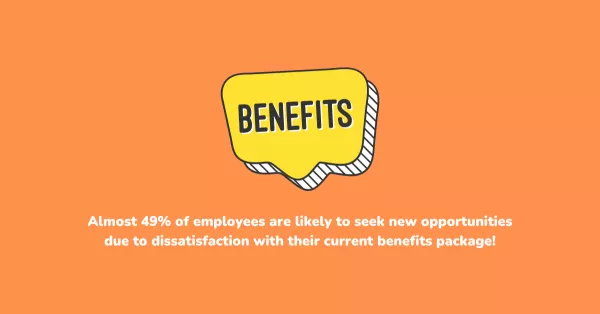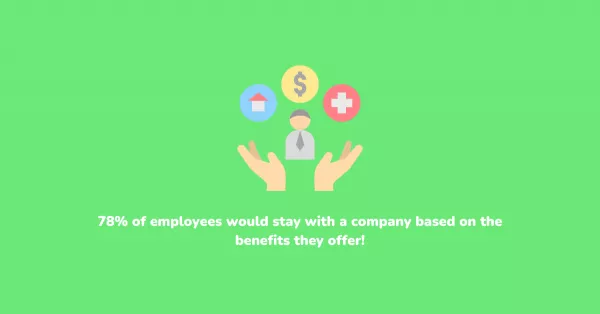Did you know that 80% of job seekers consider a company's employee benefits package when making a decision about a new position? In today's competitive job market, offering a comprehensive and well-managed benefits program is no longer a perk, it's a necessity to attract and retain top talent.
Employee benefits administration is the crucial behind-the-scenes function that ensures employees receive the valuable benefits they deserve. It encompasses the entire lifecycle of employee benefits, from selecting the right plans for the company to enrolling employees, processing claims, and keeping everyone informed. Think of it as the central nervous system of your employee benefits program, ensuring everything runs smoothly and efficiently. So what are the advantages this offers?
Benefits for Employers
A strong benefits administration system offers a multitude of advantages for employers. Here's how it can contribute to your company's success:
- Attract and Retain Top Talent - Competitive benefits packages are a major draw for qualified candidates. Effective administration ensures a positive employee experience from enrollment onwards, fostering loyalty and reducing turnover.
- Reduce Costs - A well-managed benefits program can help control costs through strategic plan selection and employee education on cost-saving options within their plans.
- Improve Employee Wellbeing - When employees have access to the right benefits and understand how to use them, it can lead to increased health, financial security, and overall well-being. This translates to a happier, more productive workforce.
Benefits for Employees
Beyond attracting talent, a well-administered benefits program offers significant advantages for employees as well:
- Financial Security - Benefits like health insurance, retirement savings plans, and disability insurance can provide a safety net for employees and their families in case of unexpected events.
- Peace of Mind - Knowing they have access to quality healthcare and financial security can give employees peace of mind, allowing them to focus on their work and personal lives.
- Sense of Value - A comprehensive benefits program demonstrates that a company values its employees and their well-being. This can lead to increased employee satisfaction and engagement.
Who Handles Benefits Administration?
The responsibility for benefits administration can vary depending on the size and structure of an organization. Here are the most common models:
- In-House HR Teams - For larger companies with dedicated HR departments, it may be handled by a team of HR professionals specializing in this area.
- Professional Employer Organizations (PEOs) - Some companies choose to outsource their benefits management to a PEO. PEOs provide a wide range of HR services, including benefits administration, for a fee.
- Third-Party Administrators (TPAs) - Companies may also utilize TPAs to manage specific aspects of their benefits program, such as claims processing or COBRA administration.
Types of Employee Benefits
Employee benefits come in various forms, each designed to address different aspects of an employee's well-being. A well-rounded benefits program typically offers a combination of the following core benefits:
Health Insurance
Health insurance is often considered the cornerstone of any employee benefits package. It provides financial protection against the high costs of medical care, including doctor visits, hospital stays, surgery, and prescription medications. There are several types of health insurance plans offered by insurers, each with its own advantages and disadvantages:
- Health Maintenance Organization (HMO) - HMO plans typically require choosing a primary care physician (PCP) who coordinates care and provides referrals to specialists within the HMO network. HMO plans often have lower premiums but may limit your choice of doctors and hospitals.
- Preferred Provider Organization (PPO) - PPO plans offer more flexibility in choosing doctors and hospitals. You can visit any provider in the PPO network with lower out-of-pocket costs, or go out-of-network for a higher cost.
- High-Deductible Health Plan (HDHP) with Health Savings Account (HSA) - HDHPs typically have lower monthly premiums but come with a higher deductible, the amount you must pay out-of-pocket before the insurance plan starts covering costs. HSAs are savings accounts paired with HDHPs that allow you to contribute pre-tax dollars to cover qualified medical expenses.
Retirement Savings Plans
Retirement savings plans are essential for employees to accumulate wealth over their working lives. While 401(k)s and traditional IRAs are foundational, contemporary benefits programs often extend beyond these traditional options.
- Roth IRAs - These offer tax-free withdrawals in retirement after contributing post-tax dollars. They are particularly beneficial for younger employees who anticipate being in a higher tax bracket during retirement.
- 403(b) Plans - Primarily used by non-profit organizations and educational institutions, 403(b) plans function similarly to 401(k)s.
- Employee Stock Ownership Plans (ESOPs) - These plans offer employees ownership stakes in the company, providing potential for both retirement savings and wealth creation through company growth.
- Auto-enrollment and Escalation - To increase participation and savings rates, many employers implement automatic enrollment and gradual contribution increases over time.
Paid Time Off (PTO)
PTO policies have evolved to accommodate modern workforce expectations. Beyond traditional vacation, sick, and personal days, progressive organizations offer:
- Unlimited PTO - While not suitable for all industries, unlimited PTO policies can empower employees to manage their time off flexibly.
- Sabbaticals - Extended periods of unpaid leave for professional development, personal enrichment, or volunteer work can boost employee morale and retention.
- Mental Health Days - Dedicated time off for mental health well-being can reduce stress and improve overall employee productivity.
- Parental Leave - Comprehensive parental leave policies, including options for both mothers and fathers, support work-life balance for new parents.
Financial Wellness Programs
Financial stress can significantly impact employee performance and job satisfaction. To address this, employers offer:
- Student Loan Repayment Assistance - Contributions towards student loan debt can attract and retain younger talent.
- Financial Education Resources - Workshops, webinars, and online tools can help employees make informed financial decisions.
- Emergency Savings Programs - Employer-matched savings programs can help employees build financial resilience.
- Adoption Assistance - Financial support for adoption expenses can be a valuable benefit for families.
Additional Benefits
Many companies offer additional benefits to enhance their employee value proposition. These may include:
- Wellness Programs - These programs promote healthy lifestyles and can include health screenings, fitness challenges, and educational resources.
- Childcare Assistance - This can include subsidies for childcare costs or on-site childcare facilities.
- Commuter Benefits - Companies may offer pre-tax commuter benefits to help employees save money on commuting costs through public transportation or parking.
By offering a diverse range of benefits, companies can cater to the various needs of their workforce and create a more attractive and supportive work environment.
The Benefits Administration Process

Effective benefits management ensures a smooth and efficient flow of operations for your employee benefits program. The core functions involved in managing employee benefits include:
Benefits Selection and Enrollment
It plays a critical role during open enrollment periods, the designated time frame for employees to choose their benefits plans and make changes to their existing coverage. This involves:
- Communication and Education - Providing clear and concise information about available plan options, eligibility requirements, costs, and any changes to the benefits program. This can be achieved through informational brochures, presentations, online resources, and Q&A sessions.
- Enrollment Support - Benefits administrators assist employees with the enrollment process, ensuring they select the appropriate coverage based on their needs and helping them navigate enrollment systems. They can also answer questions and address any concerns employees may have.
- Decision Support Tools - Benefits management may leverage online decision-support tools to help employees compare plan options and make informed decisions. These tools can provide personalized recommendations based on factors like employee age, family size, and health history.
Ongoing Administration
Administration of benefits goes beyond open enrollment. Here's a glimpse into the day-to-day tasks:
- Claims Processing - Benefits admins work as liaisons between employees and insurance providers to facilitate claims processing. This involves reviewing claims submissions, ensuring they meet eligibility requirements, and communicating with providers regarding any issues. They also work to resolve claim denials and ensure employees receive the benefits they are entitled to.
- Beneficiary Management - Maintaining accurate beneficiary information is crucial. Benefits administrators ensure beneficiary designations are up-to-date and handle any changes requested by employees.
- COBRA Administration - The Consolidated Omnibus Budget Reconciliation Act (COBRA) allows qualified individuals to continue health insurance coverage under an employer's group plan after certain qualifying events, such as job loss. Benefits administrators manage COBRA administration, including enrollment, premium collection, and communication with COBRA continuation participants.
- Recordkeeping and Reporting - Benefits administrators maintain accurate records of employee benefits enrollment, contributions, and claims activity. They also generate reports for HR, finance, and other stakeholders to provide insights into program performance and identify areas for improvement.
Communication and Education
- Clear and Consistent Communication - Effective communication is paramount in benefits management. Benefits administrators develop and distribute clear and consistent communication materials to keep employees informed about their benefits program. This may include benefit summaries, FAQs, plan updates, and information about new benefit offerings.
- Multiple Communication Channels - Utilize various communication channels to reach all employees effectively. This can include email, company intranet, newsletters, benefits portals, and even town hall meetings.
- Targeted Communication - Consider targeted communication strategies to address specific needs of different employee groups. For example, new hires might require more comprehensive information about the benefits program, while older employees may be interested in information about retirement savings options.
Technology in the Administration of Benefits
- Benefits Administration Systems - These systems (BAS) can significantly streamline benefits processes. These systems can automate tasks like enrollment processing, claims management, and eligibility verification. They can also provide employees with self-service tools to access their benefits information, update beneficiary information, and submit claims online.
- Data Security and Privacy - With the increasing use of technology, data security and privacy become paramount concerns. Benefits administrators must ensure that employee benefits data is secure and protected from unauthorized access. This includes implementing data encryption protocols, access controls, and employee training on data security best practices.
By effectively managing these core functions, benefits administration ensures the smooth operation of your employee benefits program, minimizes errors, and provides a positive experience for both employees and the company.
Challenges in the Administration of Benefits
While benefits management plays a crucial role in supporting a happy and productive workforce, it also comes with its own set of challenges. Here, we explore some of the complexities that benefits administrators need to navigate:
- Keeping Up with Regulations - The world of employee benefits is subject to a complex and ever-changing regulatory landscape. Benefits administrators must stay updated on federal and state regulations affecting different aspects of employee benefits, such as health insurance reform (ACA), retirement savings plans (ERISA), and COBRA continuation coverage. Failure to comply with regulations can result in penalties for the company and could potentially impact employee benefits.
- Data Security and Privacy - Employee benefits data, including personal health information and financial data, is highly sensitive. Benefits administrators have a responsibility to ensure the security and privacy of this data. This includes implementing robust security measures to prevent data breaches and unauthorized access. In addition, benefits administrators must comply with data privacy regulations such as HIPAA for health information and be mindful of consumer privacy rights.
- Employee Education and Engagement - One of the biggest challenges lies in ensuring employees have a clear understanding of their benefits program and how to utilize it effectively. Many employees may not take full advantage of available benefits due to a lack of knowledge or confusion about plan options and eligibility requirements. Benefits administrators need to develop effective communication and education strategies to keep employees informed and engaged with their benefits program. This may involve creating easy-to-understand resources, offering educational workshops, and providing ongoing support to answer employee questions.
- Cost Management - The cost of employee benefits can be a significant expense for companies. Benefits administrators need to be mindful of cost-containment strategies while still providing valuable benefits to employees. This may involve negotiating favorable rates with benefit providers, conducting regular program reviews to identify cost-saving opportunities, and exploring alternative benefit options.
Additional Considerations
Beyond these core challenges, it may also face complexities related to:
- Mergers and Acquisitions - When companies merge or acquire other businesses, it can lead to the need to integrate different benefits programs. Benefits administrators need to navigate the complexities of harmonizing benefit offerings and ensuring a smooth transition for employees of both companies.
- Global Workforce - Companies with a global workforce face additional challenges in managing employee benefits across different countries with varying regulations and healthcare systems. Benefits administrators need to be familiar with international benefits considerations and may need to partner with local benefits providers to ensure compliance and meet the needs of employees in different locations.
By acknowledging these challenges and developing proactive strategies to address them, benefits administrators can ensure a well-functioning benefits program that delivers value to both the employer and the employees.
The Future of Administration of Benefits

The landscape of employee benefits is constantly evolving, driven by technological advancements, changing workforce demographics, and a growing focus on employee well-being. Benefits management needs to adapt to these trends to remain effective and provide value in the years to come. Let's explore some key areas shaping the future:
- Focus on Wellness - Employee well-being is becoming a top priority for many companies. This translates to a growing focus on benefits that promote physical, mental, and financial wellness. Benefits administrators can expect to see an increase in offerings such as on-site fitness centers, mental health resources, financial planning workshops, and student loan repayment assistance programs.
- Flexibility and Customization - The one-size-fits-all approach to benefits is becoming less relevant. Employees today increasingly value flexibility and the ability to personalize their benefits selections. BAS with robust customization features will be crucial to cater to diverse employee needs.
- Automation and Streamlining - Technology will continue to play a significant role in automating manual tasks and streamlining the administration processes. These systems will evolve to offer advanced functionalities for tasks like eligibility verification, claims adjudication, and benefits communication. This will free up time for benefits administrators to focus on more strategic initiatives.
- Data-Driven Decision Making - Benefits administrators will increasingly leverage data insights to gain valuable insights into program performance, identify cost-saving opportunities, and make data-driven decisions about benefit offerings.
- Proactive and Strategic Approach - The role of managing benefits is shifting from a purely administrative function to a more strategic one. Benefits administrators will need to become strategic partners within the HR department, collaborating with leadership to design and implement benefits programs that align with business goals and attract and retain top talent.
The future of administration of benefits is one of continued evolution and adaptation. By embracing these emerging trends and leveraging technology effectively, benefits administrators can ensure their programs remain relevant and provide a competitive advantage for their companies.
Why OrangeHRM?
Centralize and streamline your HR operations with OrangeHRM's intuitive employee management module. This powerful tool eliminates the need for scattered spreadsheets and paper files, giving you a single source of truth for all your employee data. Find out what OrangeHRM can do for your organization by booking a FREE demo today!
